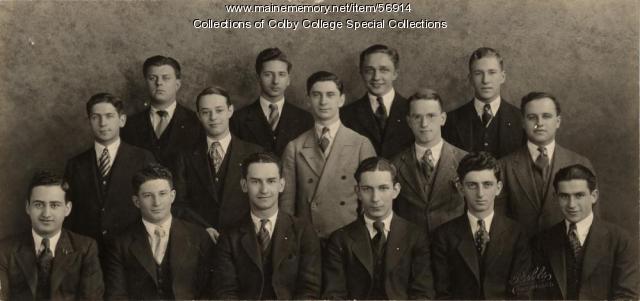Keywords: Fraternities
Item 101443
John Martin Dancing Fraternity card, Bangor 1868
Contributed by: Maine Historical Society and Maine State Museum Date: 1868 Location: Bangor Media: Lithograph
Item 69818
Kappa Delta Phi, Farmington State Normal School, 1941
Contributed by: Mantor Library at UMF Date: 1941 Location: Farmington Media: Photographic print
Item 36660
52-62 Center Street, Portland, 1924
Owner in 1924: Portland Fraternity Use: Club House
Item 39019
Assessor's Record, 15 Henry Street, Portland, 1924
Owner in 1924: The Fraternity Co. Use: Mercantile
Item 150978
Study for Eta Chapter of Theta Delta Chi at Bowdoin College, Brunswick, ca. 1904
Contributed by: Maine Historical Society Date: circa 1904 Location: Brunswick Client: Eta Chapter of Theta Delta Chi Fraternity Architect: Frederick A. Tompson
Item 151026
Westbrook Fraternal Building, Westbrook, 1921
Contributed by: Maine Historical Society Date: 1921 Location: Westbrook Client: unknown Architect: John P. Thomas
Exhibit
This collection of images portrays many buildings in Sanford and Springvale. The images were taken around the turn of the twentieth century.
Exhibit
Dressing Up, Standing Out, Fitting In
Adorning oneself to look one's "best" has varied over time, gender, economic class, and by event. Adornments suggest one's sense of identity and one's intent to stand out or fit in.
Site Page
John Martin: Expert Observer - Dancing Fraternity, City of Bangor, 1868
"Dancing Fraternity, City of Bangor, 1868 John Martin: "Terpsichorian of the Old School" John Martin, Bangor, ca."
Site Page
Strong, a Mussul Unsquit village - Grand Army of the Republic
"consisted of three things: fraternity, charity, and loyalty. Fraternity was based on regular scheduled local meetings."
Story
John Coyne from Waterville Enlists as a Railroad Man in WWI
by Mary D. Coyne
Description of conditions railroad men endured and family background on John Coyne.
Lesson Plan
Building Community/Community Buildings
Grade Level: 6-8
Content Area: Social Studies
Where do people gather? What defines a community? What buildings allow people to congregate to celebrate, learn, debate, vote, and take part in all manner of community activities? Students will evaluate images and primary documents from throughout Maine’s history, and look at some of Maine’s earliest gathering spaces and organizations, and how many communities established themselves around certain types of buildings. Students will make connections between the community buildings of the past and the ways we express identity and create communities today.


















